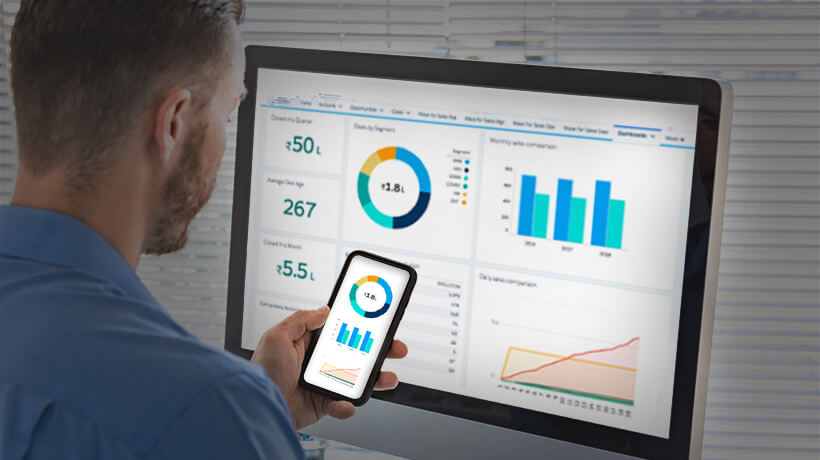
This article explores the definition and benefits of Sales Enablement programs, along with key strategies and best practices to enhance their impact. It also presents 10 recommendations on how eLearning can be leveraged to accelerate sales.
What is Sales Enablement?
The Forrester group defines Sales Enablement as:
“A strategic, ongoing process that equips all client-facing employees with the ability to consistently and systematically have a valuable conversation with the right set of customer stakeholders at each stage of the customer’s problem-solving life cycle to optimize the return of investment of the selling system.”
Sales Enablement is all about equipping the sales teams with ammunition that will help them improve their productivity and achieve their targets. This approach helps you align many functions within your organization to the overall goals and ensure that the customers see the required value.
Sales Enablement programs typically include support at many levels starting from recruitment, onboarding, training, just-in-time resources, as well as ongoing support through tools (like CRM and platforms or portals for information sharing and collaboration) and technology (for instance, analytics that can provide data-driven, actionable insights).
A successful Sales Enablement approach helps you take your sales strategy to a successful execution and enables you to meet your goals.
It is important to note that Sales Enablement is different from Sales Training. In fact, Sales Training is only one of the many pillars that will help your team succeed. Worldwide, CEOs and Sales Heads are moving toward the adoption of this holistic approach (in contrast to Sales Training alone) to equip their sales teams and create a sustainable edge over their competition.
What Are the Benefits of Adopting a Sales Enablement Based Approach?
The right Sales Enablement approach brings several benefits to organizations. The notable ones are:
- Ability to scale talent: When all team members are equipped with consistent messaging and tools, success becomes scalable. You no longer rely solely on a few high performers—instead, you build a broader, high-performing team.
- Boost productivity with data-backed preparation: With the right tools and technology, your team has access to buyer insights, preferences, and pain points. This knowledge helps them better understand prospects and improves their strategic approach.
- Faster deal closures: Well-prepared reps with research-backed pitches and ready-to-use resources can drive more efficient, targeted conversations—resulting in shorter sales cycles.
- Sustained customer engagement: Providing reps with relevant, value-adding resources enables continuous, meaningful interactions with clients, keeping them engaged even beyond immediate deals.
Inside the Role: What Sales Enablement Professionals Really Do
At the heart of every effective Sales Enablement strategy is a team dedicated to equipping sellers with the tools, insights, and support they need to succeed. Team structures vary depending on the organization’s size—smaller teams may wear multiple hats, while larger ones often build out specialized roles. Still, the core responsibilities remain consistent, focusing on strategy, content, and coaching.
Key roles typically include:
- Sales Enablement Manager – Drives strategy, aligns enablement initiatives with business goals, and coordinates across departments.
- Content Strategist – Develops and maintains impactful assets like pitch decks, product sheets, case studies, and messaging frameworks.
- Sales Trainer – Delivers onboarding, continuous training, and coaching to improve seller confidence and performance.
No matter the setup, the shared goal is clear: help sales teams sell smarter and win more.
Strategies and Best Practices to Enhance Sales Enablement
Sales Enablement must operate both at a strategic (program) and tactical (execution) level. The following combined strategies and best practices ensure robust program design and effective implementation:
- Deliver ongoing and role-based training: Move beyond periodic learning. Offer daily, bite-sized, role-specific content to keep skills sharp and aligned with current challenges.
- Layer training with coaching, mentoring, and shadowing: Structured programs should be reinforced with real-time support. Trained mentors and coaches help contextualize learning and drive behavioral change.
- Personalize learning and enablement paths: Blend standard training with personalized content tailored to specific roles, sales stages, or performance metrics—automated via platforms or learning paths.
- Leverage success stories: Use real-life wins as learning moments. Capture them through video or storytelling formats to inspire and replicate winning behaviors.
- Align Sales with Marketing and Support Functions: Break silos through regular collaboration with other departments. Unified templates, messaging, and shared tools accelerate deal movement and remove roadblocks.
- Enable learning in the flow of work: Integrate learning into daily systems like CRMs or mobile tools. On-demand resources ensure that reps can learn and apply without workflow disruption.
- Centralize and curate content: Use intuitive, searchable platforms to house all assets. AI-based content recommendation engines can guide reps to the most relevant material based on their role or activity.
- Track and optimize with analytics: Monitor enablement efforts through key performance indicators (KPIs), such as engagement, learning completion, and impact on sales results. Use this data to refine strategies continuously.
How Can eLearning Help in Improving Your Sales Enablement Program and Accelerating Sales?
Here are 10 recommendations that will help you leverage eLearning to improve the impact of your Sales Enablement program and accelerate sales. Essentially, eLearning can help you train your sales team faster with a consistent messaging (training courses) and provide just-in-time support on the field (crucial learning resources).
- Adoption of Mobile Learningis a great way to help sales reps take training on the go (anytime, anywhere, and exactly at the moment of their need). You could also invest on using Mobile Apps. You can push updates, additional resources, and other just-in-time learning aids through this with ease.
- You can provide a mix of learning resources for formal training as well as just-in-time learning aids (Cheat sheets for scripts, Case studies, Use Cases, Product sheets, Competition analysis and so on). The sales team members can have self-paced, short training sessions that can help them learn, refresh, review, prep before a call or a meeting and so on.
- Additionally, opting for Microlearning based trainingensures you can offer short, bite-sized training that can be connected over a learning pathway.
- You can build further on the Microlearning based training to offer highly personalized learning assets (given the role or product/service the team member is working on).
- Microlearning-based training can incorporate video-based learning. You can use traditional or interactive videos to create engaging and immersive learning experiences that support real-world application.
- You can add Scenario Based Learning featuring complex Branching Simulations that help sales teams go through real-life situations and practice in a safe environment. Through this, you are helping them hone their skills, improve their decision-making skills, and stimulate critical thinking.
- You can use techniques like Gamificationwith leaderboards and badges to gain proficiency levels.
- You can also add Micro Challenges (for instance, short Gamified assessments) to validate or reinforce learning and keep the sales team members on their toes.
- The next gen platforms like LXPs can be used to design these learning pathways. These go a long way in fostering a spirit of continuous learning. You can leverage the other features of LXPs like Social or collaborative learningand career pathways to ensure that sales team members are connected and will keep coming back for more.
- You can also invest on recommended, additional learning resources through Curation and ensure curated, relevant content to the team members. Today, many platforms use AI techniques to offer these recommendations.
As you would have noted, Sales Enablement can help you bridge the gap between sales strategy and its execution. It equips your sales teams to perform better and brings in higher, cross-functional collaboration.



